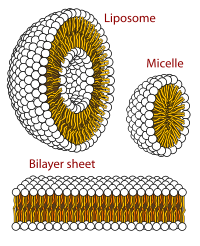
Lipid polymorphism
Encyclopedia

Lipid
Lipids constitute a broad group of naturally occurring molecules that include fats, waxes, sterols, fat-soluble vitamins , monoglycerides, diglycerides, triglycerides, phospholipids, and others...
s that influences their long-range order, i.e. how they aggregate. This can be in the form of spheres of lipid molecules (micelle
Micelle
A micelle is an aggregate of surfactant molecules dispersed in a liquid colloid. A typical micelle in aqueous solution forms an aggregate with the hydrophilic "head" regions in contact with surrounding solvent, sequestering the hydrophobic single tail regions in the micelle centre. This phase is...
s), pairs of layers that face one another (lamellar phase, observed in biological system as a lipid bilayer
Bilayer
A bilayer is a double layer of closely packed atoms or molecules. The properties of bilayers are studied in condensed matter physics, often in the context of semiconductor devices, where two distinct materials are united to form junctions ....
), a tubular arrangement (hexagonal
Hexagonal crystal system
In crystallography, the hexagonal crystal system is one of the 7 crystal systems, the hexagonal lattice system is one of the 7 lattice systems, and the hexagonal crystal family is one of the 6 crystal families...
), or various cubic
Cubic crystal system
In crystallography, the cubic crystal system is a crystal system where the unit cell is in the shape of a cube. This is one of the most common and simplest shapes found in crystals and minerals....
phases (Fd3m, Im3m, Ia3m, Pn3m, and Pm3m being those discovered so far). More complicated aggregations have also been observed, rhombohedral, tetragonal and orthorhombic phases have been observed.
It forms an important part of current academic research in the fields of membrane biophysics
Membrane biophysics
Membrane biophysics is the study of biological membranes using physical, computational, mathematical, and biophysical methods....
(polymorphism), biochemistry
Biochemistry
Biochemistry, sometimes called biological chemistry, is the study of chemical processes in living organisms, including, but not limited to, living matter. Biochemistry governs all living organisms and living processes...
(biological impact) and organic chemistry
Organic chemistry
Organic chemistry is a subdiscipline within chemistry involving the scientific study of the structure, properties, composition, reactions, and preparation of carbon-based compounds, hydrocarbons, and their derivatives...
(synthesis).
Determination of the topology of a lipid system is possible by a number of methods, the most reliable of which is x-ray diffraction. This uses a beam of x-rays that are scattered by the sample, giving a diffraction pattern as a set of rings. The ratio of the distances of these rings from the central point indicates which phase(s) are present.
The structural phase of the aggregation is influenced by the ratio of lipids present, temperature, hydration, pressure and ionic strength (and type).
Hexagonal phases in the lipid polymorphism
In lipid polymorphism, if the packing ratio of lipids is greater or less than one, lipid membranes can form two separate hexagonal phases, or nonlamellar phases, in which long, tubular aggregates form according to the environment the lipid is introduced.Hexagonal I phase (HI)
This phase is favored in detergent-in-water solutions and has a packing ratio of less than one. The micellar population in a detergent/water mixture cannot increase without limit as the detergent to water ratio increases. Therefore, in the presence of low amounts of water, lipids that would normally form micelles actually form a larger aggregate in the form of micellar tubules in order to satisfy requirements of the hydrophobic effect. These aggregates can be thought of micelles that are fused together. These tubes have polar head groups facing out, and the hydrophobic, hydrocarbon chains facing the interior. This phase is only seen under unique, specialized conditions, and most likely is not relevant for biological membranes.Hexagonal II phase (HII)
Lipid molecules in the HII phase pack inversely to the packing observed in the hexagonal I phase described above. This phase has the polar head groups on the inside and the hydrophobic, hydrocarbon tails on the outside in solution. The packing ratio for this phase is less than one, which is synonymous with an inverse cone packing.Extended arrays of long tubes, as in the hexagonal I phase, and due to the nature of the polar head groups packing, aqueous channels are formed. These arrays can stack together like pipes. This way of packing may leave a finite hydrophobic surface in contact with water on the outside of the array. However, the otherwise energetically favorable packing apparently stabilizes this phase as a whole. It is also possible that an outer monolayer of lipid coats the surface of the collection of tubes to protect the hydrophobic surface from interaction with the aqueous phase.
It is suggested that this phase is formed by lipids in solution in order to compensate for the hydrophobic effect. This structures tight packing of the lipid head groups reduces their contact with the aqueous phase. This, in turn, reduces the amount of ordered, but unbound water molecules.
The most common lipids that form this phase include phospatidylethanolamine (PE), which has unsaturated hydrocarbon chains. Diphosphatidylglycerol (DPG) in the presence of calcium is also capable of forming this phase.
Techniques for detection
There are several techniques used to map out which phase is present during perturbations done on the lipid. These perturbations include pH changes, temperature changes, pressure changes, volume changes, etc.The most common technique used to study phospholipid phase presence is phosphorus nuclear magnetic resonance (31P NMR). In this technique, different and unique powder diffraction patterns are observed for lamellar, hexagonal, and isotropic phases. Other techniques that are used and do offer definitive evidence of existence of lamellar and hexagonal phases include freeze-fracture electron microscopy, X-Ray diffraction, differential scanning calorimetry (DSC), and deuterium nuclear magnetic resonance (2H NMR).

